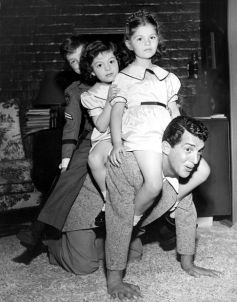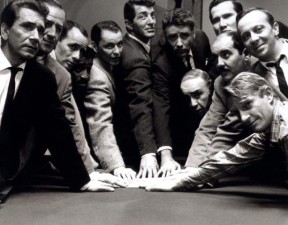
“If people want to think I get drunk and stay out all night, let ’em. That’s how I got here, you know.” –Dean Martin
There are many fine singers who made their mark upon classic Hollywood cinema and the Great American Songbook. From working as a crooner, to acting as one-half of a popular comedy partnership, to being a member of the Rat Pack, Dean Martin was a performer who maintained an easygoing presence that was both classy and cool. Collaborating with the likes of Frank Sinatra, Sammy Davis Jr., Joey Bishop, and an occasional Peter Lawford, Martin would soon find himself a beloved American icon.
Dino Paul Crocetti was born on June 7, 1917, to Gaetano and Angela Crocetti. His father was a barber, originally from Montesilvano, Italy, while his mother was a seamstress. The couple first had a son named William Alfonso Crocetti, followed by Dino.
Growing up, Martin’s first language was Italian. When he turned five years old and prepared for elementary school, he started to speak more English. Martin attended Grant Elementary School, where he was initially bullied for speaking broken English. As he grew, he developed an interest in drums. He would later drop out of Steubenville High School during his sophomore year because he thought he was smarter than his educators.
Rather than continuing on as a student, Martin bootlegged liquor, worked in a steel mill, boxed, and was a blackjack dealer. During his teen years as a boxer, he was billed as “Kid Crochet.” Martin wound up with many injuries, since he could not afford the tape required to wrap boxers’ hands.
After Martin gave up boxing, he spent time working several jobs at a casino. At the same time, he began to sing with local bands, billing himself as “Dino Martini.” His first major crooning opportunity occurred when he worked for the Ernie McKay Orchestra. By 1940, he started to sing for bandleader Sammy Watkins, who suggested that he work under the name Dean Martin.

In 1941, Martin married Elizabeth “Betty” Anne McDonald in Cleveland and moved to an apartment in Cleveland Heights. The couple had four children before divorcing in 1949. Throughout this time, Martin worked for various bands, thanks to his looks and personality, later developing his own style of singing. In 1943, he met Frank Sinatra at the Riobamba nightclub in New York. Martin’s performance following Sinatra’s was a flop. Shortly afterwards, Martin was drafted into the U.S. Army, serving one year in Akron, Ohio, before he was reclassified as 4-F and discharged due to a double hernia.
By the late 1940s, Martin was performing as a nightclub singer on the East coast. While doing so, he met comic Jerry Lewis at the Glass Hat Club in New York, where they were both performing. They quickly became friends and started to participate in each other’s acts, forming a music-comedy team. Their debut as comedic partners occurred at the 500 Club in Atlantic City, though they were not well received. After the nightclub owner threatened to fire them if they did not come up with a better act, Martin and Lewis returned to the stage with as many jokes, slapstick performances, songs, and skits as possible. The act was a success, leading to many engagements throughout the East coast.
Martin and Lewis made their television debut on the first broadcast of The Ed Sullivan Show, hiring on Norman Lear and Ed Simmons to help write their skits. They began a radio series in 1949 and signed with Paramount in the same year. In addition to appearing in films, they also controlled their club, record, radio, and television appearances. The two continued to be close friends, with Lewis acting as best man when Martin remarried in 1949. However, their films became repetitive, leading Martin to become dissatisfied with the act. They broke up in 1956 after being a team for 10 years.
Martin’s first solo endeavor after ending his partnership with Lewis was in the film Ten Thousand Bedrooms (1957), which was a flop. With rock and roll increasing in popularity, Martin’s fame as a crooner was at risk. He wanted to develop a persona as a dramatic actor, even though he had made a name for himself in comedies. His next film was The Young Lions (1958), alongside Marlon Brando and Montgomery Clift. Later, Martin starred with Sinatra for the first time in Some Came Running (1958).
By the mid-1960s, Martin was actively working in movies, music, television, and nightclubs. He teamed with John Wayne in Rio Bravo (1959) and The Sons of Katie Elder (1965). As a change of pace, Martin starred in the film version of Bells Are Ringing (1960) with Judy Holliday. Martin and Sinatra would team up for many more films, including Ocean’s 11 (1960), Seargeants 3 (1962), 4 for Texas (1963), Robin and the 7 Hoods (1964), and Marriage on the Rocks (1965). He would continue on to star in several comedies as well as in the successful drama, Airport (1970).
As Martin’s solo career flourished, so did his friendship with Sinatra. Like Sinatra, Martin was unable to read music, but recorded more than 600 songs. For over three decades, Martin was one of the most popular acts in Las Vegas. As part of the Rat Pack, a group of social friends, Martin would dress in a tuxedo and perform songs, in addition to partaking in improvised slapstick and conversation. Their jokes focused primarily on adult themes. Behind the scenes, Martin and Sinatra supported the civil rights movement, refusing to perform in clubs that would not allow African-American performers.
By 1965, Martin launched a variety show, called The Dean Martin Show. The series ran until 1974, showcasing the improvisational skills of Martin and his many guests. The loose format of the show caught the eye of the NBC censors, who were fielding complaints from Italian-speaking audience members noticing Martin’s use of obscene Italian phrases throughout the show. Nonetheless, the show often appeared in the Top Ten.
Though Martin maintained a persona as a drunk onstage, his drinking was far more controlled behind the scenes. He preferred working in nightclubs, as opposed to huge stadiums, and was uninterested in drinking until dawn following major performances.
Martin’s last recordings were done for Warner Brothers Records. While the Jerry Lewis MDA Telethon was occurring in 1976, Sinatra shocked Lewis by bringing Martin out on stage, leading to an embrace and reconciliation. This memorable moment, along with the tragic passing of Martin’s son, helped bring Martin and Lewis together again. Though they were friends again, they only performed together once more in 1989 for Martin’s birthday.
Martin died from lung cancer, as a result of heavy smoking, on December 25, 1995. The lights of the Las Vegas Stripped were dimmed in his honor. His epitaph in Westwood Village Memorial Park Cemetery features the title of his signature song, “Everybody Loves Somebody Sometime.”
Today, Martin is remembered fondly in his hometown of Steubenville. Visitors can stop by the Steubenville Visitors Center to take a photograph with a life-sized cardboard cutout of Martin at 120 S. 3rd St. The Dean Martin Festival occurs annually, attracting Martin aficionados from all over the nation and beyond. There is also a Dino Dash 5K run for athletes looking to celebrate Martin.
In addition to these attractions, there are several locations around town that honor Martin. While his childhood home no longer stands, the site of the home is marked with a sign at 3195 S. 6th St.

Near East Elementary, one can also spot the Dean Martin Historical Marker on State Rd. 7.

There is also a stretch of Route 7 named after Martin, marked with a sign that reads “Dean Martin Boulevard”, featuring his caricature.

In town, no trip to the supermarket is complete without walking past a mural in honor of Martin, which is painted onto the side of the building. The center of the mural portrays Martin singing, while the additional panels surrounding him depict different eras in his life. One of the panels also showcases Martin’s return visit to Steubenville in 1950, where he was accompanied by his wife and Lewis. The town threw a parade in Martin’s honor. The mural is located on 350 S. Hollywood Blvd.
Not far away, the Jefferson County Historical Museum and Library contains a Dean Martin Room, featuring a wide range of memorabilia relating to Martin’s life and career. The museum is located at 426 Franklin Ave.

Martin continues to be an iconic figure who is recognized the world over. In addition to enjoying the many films and recordings Martin made throughout his lifetime, he can also be celebrated by a visit to his hometown.
This post originally appeared in Annette’s Hometowns to Hollywood column for TCM Backlot. View the original article here.













































Pingback: Grauman’s Chinese Theatre Forecourt | Hometowns to Hollywood
What was martins first gig after leaving Steubenville Ohio
Pingback: Westwood Village Memorial Park | Hometowns to Hollywood
Pingback: Holy Cross Cemetery | Hometowns to Hollywood
Pingback: Tony Curtis | Hometowns to Hollywood
Pingback: King of Cool (2021) | Hometowns to Hollywood
Pingback: Vivian Blaine | Hometowns to Hollywood
Pingback: Frank Sinatra | Hometowns to Hollywood
Pingback: Marcy McGuire | Hometowns to Hollywood